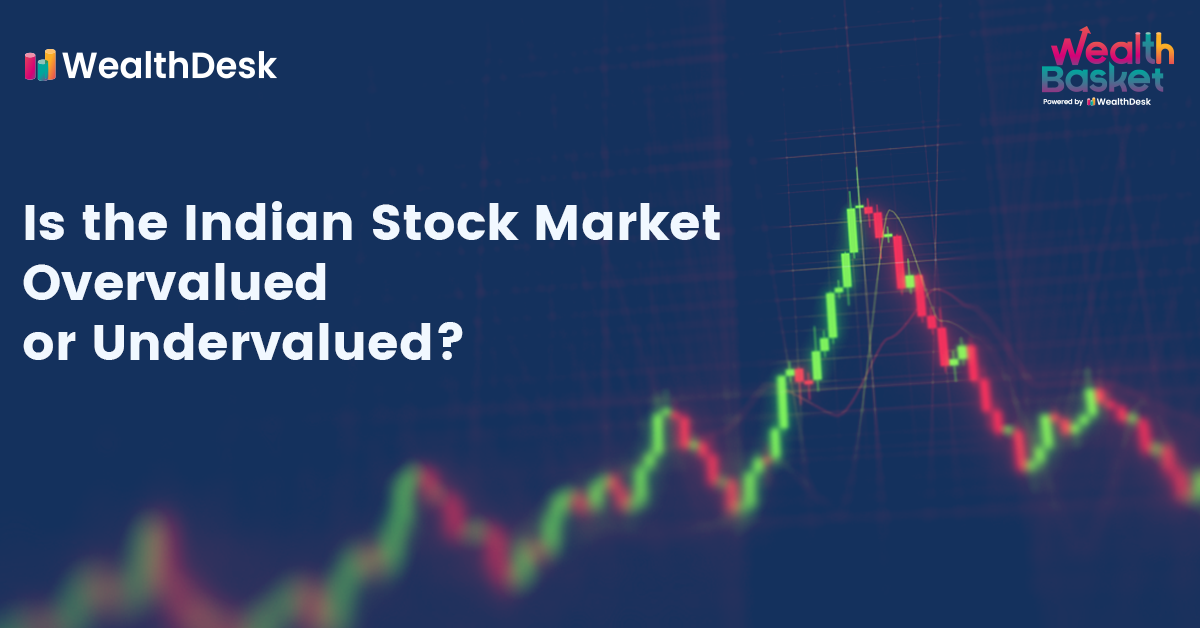In 2021, the Indian stock market hit record highs in many terms. In October, BSE Sensex reached 62,245 points, and even while closing in December, it was above the 57,000 mark. Nifty also crossed 17000 levels earlier in the year.
Economic bottlenecks have persisted, but these indices have performed exceptionally well. And that’s reason enough for analysts to believe that the Indian stock market is currently experiencing an overvalued bubble.
But what exactly is Indian stock market valuation all about? What are overvalued and undervalued stocks? And most importantly, what does a stock market overvalued bubble mean for you? Keep reading to know all of these answers and more!
What Are Overvalued and Undervalued Stocks?
Typically, when a stock’s price is much higher than what should be its intrinsic value, as calculated by its P/E ratio (usually considering long-term average P/E), it is called overvalued.
On the contrary, a stock with a significantly lower price than its intrinsic value is undervalued.
What is a Stock Market Bubble?
In financial markets, a stock or a financial asset is in bubble territory when priced significantly higher than its fundamental value. If the stock price is overvalued for a considerable period, it can be in a bubble.
A bubble usually occurs because of opportunistic and speculative buying. Market participants are responsible for driving stocks into bubble categories.
People expect the prices to rise, leading them to buy more of a share, which increases the demand for the share, increasing its price much more than its inherent worth.
When bubbles burst, panic selling follows, causing the demand to fall, supply to rise, and consequently, the share price crashes at high speed.
Consequently, the risk for losses runs higher as the bubble may burst anytime. The most famous example of bubble territory is the 2007 housing crisis in the US.
How to know whether the Stock Market is Overvalued or Undervalued?
Whether a stock is overvalued is hard to predict. However, analysts and economists use many indices to gauge the situation.
Indicators to track for learning whether the stock market is overvalued or not:
Stock Market Capital to GDP ratio
The stock market capitalization to GDP ratio calculates whether the stock market is overvalued or undervalued. It is computed by dividing the current stock market capitalization (sum of the market capitalization of all listed companies) by the gross domestic product (GDP).
Between 50-75%, the market is said to be undervalued. A value between 75-90% is fair. When the value crosses 100%, it is believed that the market is overvalued. The ratio is also called the Buffet indicator.
Price to Earnings Ratio
It is calculated by dividing the company’s share price by its earnings per share. It tells investors whether a particular share is overvalued or not. A high P/E ratio is often not suitable for investors.
Price to Book Value per share
The price to book value of a share tells about a company’s earning capacity. Conservative investors use it as it helps to calculate the ‘safety margin’ available to investors. The P/B ratio is reached by dividing the market value of the share by a company’s last quarter book value per share.
Is the Stock Market Overvalued Right Now?
Based on the performance of key indices like BSE Sensex and NSE Nifty50 throughout 2021, and the performance of the indicators mentioned above, the stock markets can be considered in an overvalued bubble.
Here are some more reasons to believe that the markets have been in this bubble for quite some time now:
- According to the Reserve Bank of India’s 2020-21 report, the stock market was overvalued based on trailing P/E as of Mar-21. Governor Shaktikanta Das also warned investors of the same in August 2021.
- Despite the effects of the COVID pandemic and a still-recovering economy, the markets are on a constant rise. This rise sure looks to be the sign of an overvalued market.
- In September, India’s Market capitalization to GDP ratio reached an all-time record of 188%.
- 2021 was a year for many IPOs. Brands like Zomato and Paytm got listed on the stock market. A change in public sentiment gave a push to the demand for stocks. There is now more demand due to initial gains in IPOs; many Demat accounts are being opened, and the number also doubled compared to the past year.
- The total debt to GDP ratio was 58.73% towards the end of FY 2020-21. Such a high number usually indicates bordering on the overvalued market.
Discover stocks that suit certain filter criteria and dive into details to check their WealthBaskets.
Is it safe to invest in stocks right now?
Investors are usually advised to behave carefully when the markets are overvalued and not get carried away with the public sentiment.
And that’s true even when markets are undervalued. Because in either case, if you’re not conscious, you might put yourself at a lot of financial disadvantage.
If you’re a long term investor, it’s better to buy high-quality stocks even if their value doesn’t seem too high at the moment because such stocks provide better results even as bubbles burst. At present, therefore, you must act prudently to navigate through this tricky market.
FAQs
If you carefully plan your investments and guard yourself against impulse purchases, you can safely invest in the Indian stock markets right now. An overvalued bubble, if at all, may not affect you negatively if you’re a wise investor buying high-quality stocks.
According to several estimates, while the economy is recovering pretty well, it will take significant time to be fully back to normal. 19 out of 22 HFIs have performed well, but the others might take more time to get back to pre-pandemic levels. This means that an overvalued bubble, if any will persist for some more time.
While a full-on market crash may not be in sight, Sensex and Nifty, which had already declined 2.5% by mid-December due to the Omicron spread, can see sharper declines if cases continue to rise. Some of this decline was seen in December 2021, and if cases rise astronomically, the fall could be steep.
Stock market bubbles are dangerous for almost all investors. They are often unpredictable and come and go without much foresight or warning, leaving you with poor decisions and losses.















